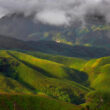Nightlife in Buenos Aires: If you like secret bars, stand-up comedy, good wine, and cheap public transportation that runs throughout the night, you can plan a trip to Buenos Aires. The city is a late-night wonderland; Head to Bolich (the club), and you’re likely to stay outside until the sun comes up. Loud and friendly, this city totally never sleeps, and the porteos (residents of Buenos Aires) know how to have a good time.
As in any city, be careful when going out. It’s generally safe to walk around at night in Buenos Aires – but petty crimes like phone theft do happen. If you’re ever in doubt about the safety of an area, order Uber to get you to your destination. Ubers are cheap and plentiful; Alternatively, many buses also run throughout the night. If you get lost or need help, most porteos will happily point you in the right direction wherever you are going.
Overall, just be Tranquillo (chill) when you go out and enjoy wherever the night takes you. With so many events happening in the city on a weekly basis, your weekend plans can change a lot from what you originally planned. Read on for where to find the country’s best microbreweries, bumpin’ festivals, corner bars with attractions, and a wide variety of live music.
Bars
The bar scene in Buenos Aires was strong even before the city’s recent craft beer boom. Head to a lovely wine bar for a glass of Malbec, or hit up a kooky concept locale for a taste of the city’s creative scene. There will be several corner bars in any neighborhood where people drink national beers like Quilms or Brahms, and those who prefer a little mystery can check out the speeches hidden under flower shops and behind sushi restaurants.
- Craft Beer Bars: Head to Strange Brewing for Sours, IPAs, and Fun Flavors. Some say this is the best microbrewery in Buenos Aires, others say the country. Club de la Birra has a wide variety of brewers and a staff that can give you a crash course in beer education.
- Concept Bar: Large, delicious, and strong cocktails can be found at Calypso. Modeled as an old San Telmo house, this bar comes with a bedroom, dining room, and parlor. Verne serves cocktails based on Jules Verne’s classic “180 Days Around the World.”
- Wine Bar: Head to Aldo Inn Microcentro for wines sold at great prices. At Vico, you can enjoy a variety of wines on tap, courtesy of self-serve dispensers.
- Speakeasies: Floreria Atlântico—hidden inside a flower shop in Retiro—is an intimate speakeasy accompanied by expertly mixed drinks. If you love sushi and mystery, make your way to Harrison Speakeasy at sushi restaurant Nicky NY Sushi’s Vault.
- Neighborhood Bar: Chin Chin has hip-hop music, rowdy locals, and reasonably priced drinks. El Boliche de Roberto has cheap drinks, live tango, and a nostalgic atmosphere.
Nightclubs
Porteños love their cumbia, reggaeton, and electronic music, so that’s what hangs out on the deck at most of the city’s mainstream clubs. Gay clubs in Buenos Aires have a great selection of pop, while alternative venues are known to play a wide variety of genres. Nightclubs here can experience a “meat market” for them. Groups of women who want to dance without boys constantly trying to pick them up will probably have more fun at a gay or alternative club.
- Mainstream Clubs: Niceto Club is one of the main venues of the Palermo nightclub circuit. It is known for hip-hop, cumbia, and techno as well as folkloric events and Club 69, a famous drag queen show held every Thursday night. For local and international DJs spinning a mix of electronic and techno music, Crowbar has two dance floors and a good sound system. In San Telmo, the Club Museum was designed by Gustave Eiffel himself; Over 1,000 people dance in EDM, cumbia, and reggaeton until dawn on weekends.
- LGBT Club: The largest and oldest gay club in Buenos Aires, America has huge warehouse space for dance shows and pop and cumbia dances all night long. Be prepared to pay a small cover fee. Feliza has several dance rooms, an arcade, hammocks, delicious food, and decent cocktails.
- Alternative: Famous for its Afroma nights of funk, soul, and hip-hop, Makena has a small dance floor but a good crowd. If you love the ’80s and smoky basement dances, check out Requiem.
- Salsa: In abasto, Azucar plays salsa, merengue, bachata and reggaeton. The dance starts earlier here than in other clubs (until 10:30 p.m.) There is a live salsa band on Friday nights at El Toque Cimarron in San Telmo.
Milongas
Milonga tango is a dance show. Some occur during the day, but many begin around midnight and last until dawn. Scattered throughout the city, different milongas will suit different interests. If you just want to watch, you can choose to watch a show with dinner.
- El Baso: With a theme night every day of the week, this venue is gay-friendly and has classes for serious beginners. Advanced dancers also appear.
- Canning Saloon: Famous for its wooden floors, many locals and tourists come to dance at this beginner-friendly milonga.
- La Nacional: Go here if you just want dinner and a tango show. Feeling Inspired? Later stop for Milonga.
Live Music and Performances
Music swirls and swirls around the streets of Buenos Aires. Maybe you’re eating your dinner in a restaurant quietly one minute, and the next minute a tango singer or small band may enter and present a small set.
If you want to visit venues dedicated to live music, Niceto Club hosts popular Argentine acts as well as international artists. Intimate folk concerts take place every Wednesday at the adjacent Open Folk, while local bands rock San Telmo’s Guevara Bar. For live tango music, check out La Catedral in Almagro. At Konex, la Bomba de Tiempo will keep your blood pumping to the beat of your famous Monday Night drumline show. If you want something really spectacular, watch an opera singer or orchestra perform at the Teatro Colón, one of the best concert venues in the world.
Comedy
There is a stand-up scene in Buenos Aires, although it is mostly in Spanish. Except for the occasional one-off show, the only stand-up BA in English is in the Comedy Lab. Shows take place approximately twice a month and feature both amateur and professional comedians. If you’re interested in the Spanish scene, Stand Up Club Microcentro has a small venue with weekly shows and open mic nights. Most places charge a small cover fee.
Festivals
Buenos Aires has a strange history of having wonderful festivals that come to an abrupt end. However, those who are stuck around know how to go hard.
- Lollapalooza: This annual festival features music lasting three days and is similar to its sister festival in Chicago. Thousands of visitors come here to see the big names of local and state artists.
- Tango Festival and World Cup: It’s not just the biggest tango festival in the world: it’s also the most important tango championship in the world. In addition to the big competition, the festival includes performances, classes, a product fair and concerts across the city.
- International Jazz Festival: Artists both established and new play classic bebop, jazz fusion, swing, and nuevo tango at this massive festival every November. Organizers love to bring in musicians who have never played in Buenos Aires. You can also find talks and free performances throughout the city.
- LGBT Pride Week and Parade: The main Pride event takes place each year in November, with over 100,000 dazzling, colorful dancers and spectators. With lots of DJs, floats, and cheap beer, the party begins in Plaza de Mayo and leads to the National Congress. A small pride takes place in Palermo in December.
Events and Activities
Food fairs, holiday parties, celebrations of different immigrant cultures, and much more can be found in Buenos Aires throughout the year. The government organizes a number of free and varied events, the schedule of which can be found on their website. One of the most famous and fun is La Noche de Los Museos when all of the city’s museums and special historic buildings are open until 3 a.m. with performances, music, food, and more.
Argentina has a strong circus subculture – and with over 20 circus schools in the capital, there is usually at least one variety show on any given weekend. Shows include aerial art, acrobatics, knife throwing, and more. Check the individual circus schools for their schedule. Trivanchi and Club de Trapesistas are two of the city’s most famous ones.
If you want to let off some steam while you’re here, head to The Break Club, where you can literally smash things like TVs, bottles, and old computers. Protective equipment and tools are provided for breaking the goods. It’s only open Wednesday through Sunday evenings, so reservations are necessary.
There are also full moon parties on the banks of the Planetarium Pond in Buenos Aires. They happen about once a month and include drum circles, fire dancing, and lots of vegetarian food.
Tips for Going Out in Buenos Aires
- Open containers are legal and common among locals.
- Trains usually stop by 12 o’clock, but buses run all night. However, if you try to take the bus after midnight, you may end up waiting for more than an hour.
- Taxis are plentiful and it’s easy to hail around town, no matter what time of night.
- Uber is the easiest way to get home. If your Uber driver says they don’t accept cards, that’s not true—just cancel and order another Uber. It is not uncommon for your driver to ask you to sit in front. There is still a lot of resentment towards Uber among taxi drivers here, and many will ask single passengers to sit in the front as a precaution.
- The final call will vary from bar to club. Some bars will be open until the sun sets, while others close at around 2 pm on weekends or 12 pm on weeknights.
- If you want to leave a tip, ten percent is standard, although it is not always expected.
- Many events are free. If there is cover at a fancier club or event, it is usually less than 600 Argentine Pesos ($10).
Similar Articles









